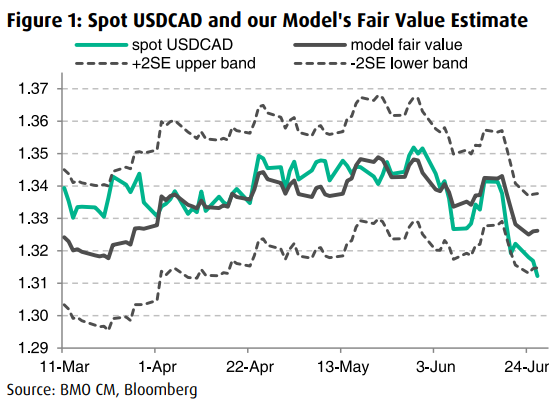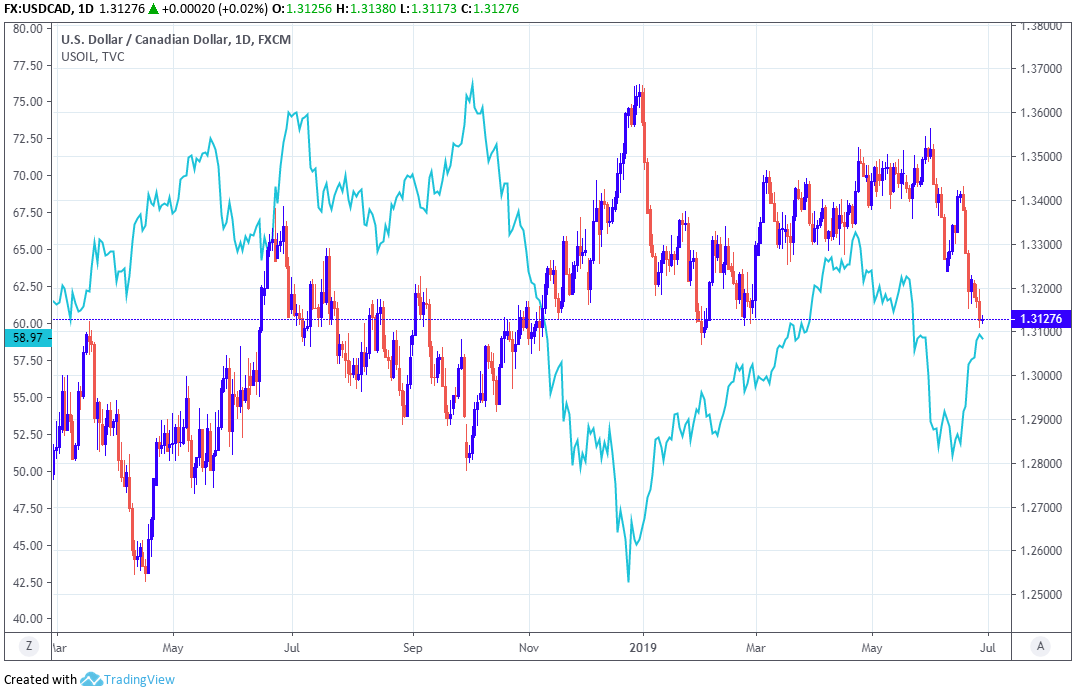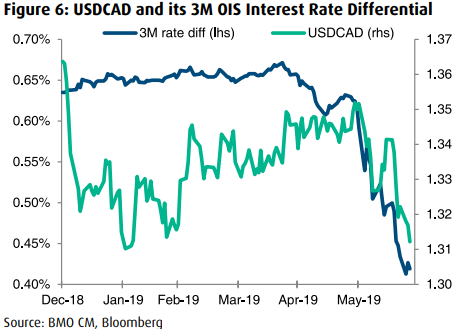The Canadian Dollar is a Buy on Dips at BMO
- Written by: James Skinner
-

Image © Jess Yu, Adobe Images
- CAD has risen above 'fair value' according to BMO financial model.
- BMO says better to buy dips further out, rather than jump straight in.
- Strategy aligns with BMO's 2019 forecast path for the CAD/USD rate.
- CAD forecast to retreat in third quarter before rallying into year-end.
Canada's Dollar has now risen above its fundamental value following a month of strong gains, according to a BMO Capital Markets financial model, so the bank has told clients it's better to wait and buy into any forthcoming dips in the currency rather than jumping straight.
The Canadian Dollar stalled at its June highs on Thursday as the G20 summit in Osaka, Japan, got underway and after North American oil prices softened during the overnight session, although it's still sitting above the level estimated to be "fair value" for it when stood next to the U.S. Dollar according to BMO.
However, the outcome of trade talks between Presidents Donald Trump and Xi Jingping in Osaka will be key to market risk appetite over the coming weeks and months as well as the outlook for the global economy. If a cease fire in the trade war is not agreed, the Canadian Dollar's advance might go into reverse.
"Our rotating financial factor model for USDCAD estimated fair value at 1.3262 at today’s 17:00 EST close. To be more statistically precise, the model estimated fair value to be within a range between 1.3148 and 1.3376 (with 95% confidence). Today's spot close came in below the lower band," says Greg Anderson, head of FX strategy at BMO.

Above: BMO graph showing USD/CAD fair value levels.
Canada's Dollar has strengthened this month and the U.S. currency weakened, driving a steep decline in the USD/CAD rate, because markets have become increasingly convinced the Federal Reserve will cut its interest rate from a post-crisis high of 2.5% to just 2% or less before year-end, while strong domestic economic data is making it difficult for the Bank of Canada (BoC) any possible future decisions to cut its own interest rate.
Unemployment fell to a new record low in Canada during the May month and all of the BoC's preferred measures of inflation are either testing the 2% target or already above it. This could mean the narrowing gap between U.S. and Canadian bond yields continues to support the Loonie for a while to come, particularly if the economy and jobs market remain in rude health.
"The model has read the 1M trend in [fair value] as downward sloping since June 7, so it is in a ‘sell spikes’ mode. A ‘spike’ is defined as a close where spot is above FV," Anderson says, in a note to clients Thursday. "We would caution against chasing the move down; we think it makes more sense to try and wait for a pullback before getting short."
BMO model's recommendation to "sell spikes" in the USD/CAD rate is equivalent to advocating a more renowned "buy on dips" strategy for the Canadian Dollar. Such an approach might be attractive to speculators especially as the estimated level of 'fair value' is rising all of the time, or falling as it's expressed using the USD/CAD rate.
However, Anderson and the FX team are mindful of the possibility that the exchange rate could rebound from its newfound trough in the short-term. And the bank is also forecasting that it will rise notably by the end of September before falling again amid an anticipated Canadian Dollar rally into year-end.
"Perhaps today's move lower in USDCAD can be ascribed to the model's #2 variable: WTI-grade crude. Thanks to a big drop in crude and product inventories, WTI rose by 2.4% today, as shown in Figure 4. However, while an improved oil outlook for crude is good news for CAD, the levels don't map real well. The last time WTI closed on a $59 round number on May 28, USDCAD rounded to 1.35," Anderson says, referring to Wednesday's price action.

Above: USD/CAD rate shown at daily intervals, alongside WTI crude oil price (aqua line, left axis).
BMO's model uses interest rate differentials, market risk appetite, oil prices and the general direction of the U.S. Dollar in order to estimate the intrinsic value of the USD/CAD exchange rate, which is almost always different from the actual rate on the market but useful as a guide to the likely range one can expect the Loonie to trade in.
Canadian government bond yields have risen and U.S yields fallen this month so that the additional return earned by investors who buy bonds in America rather than Canada has now reduced in a way that is favourable to the Loonie.
This was due to the latest evolution of Fed interest rate policy and a solid performance from the Canadian economy, with the resulting movement in bond yields dragging the USD/CAD rate lower and pushing up most other Canadian exchange rates including the Pound-to-Canadian-Dollar rate.
"One variable type that maps with the sharp move lower in USDCAD is the interest rate differential category. At all tenors, IRDs have moved ferociously in favour of CAD over the past month as fixed income markets have moved to price in 2 more rate cuts by the Fed than by the BoC," Anderson says. "This variable has 'fair value' for USDCAD on a 1.32 round figure today. So even by this measure, spot USDCAD appears to have overshot a bit to the downside."
Anderson and the BMO team say the USD/CAD rate is likely to end June at 1.32 and that it will rise to 1.34 by the end of September, as financial markets begin to focus on risks associated with the October general election.
Both the above forecasts imply a correction lower, or dip, in the Canadian Dollar over the coming months although BMO also forecasts the a rally into year-end that is expected to take the USD/CAD rate back down to 1.32 by the end of December and to 1.30 by the end of June 2020. The forecasts are outlined in greater detail here.

Above: BMO graph showing USD/CAD correlation with 3-month bond yield differential.
Time to move your money? Get 3-5% more currency than your bank would offer by using the services of foreign exchange specialists at RationalFX. A specialist broker can deliver you an exchange rate closer to the real market rate, thereby saving you substantial quantities of currency. Find out more here.
* Advertisement









